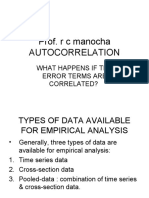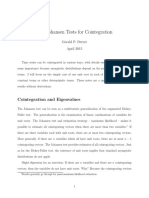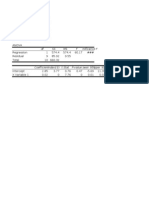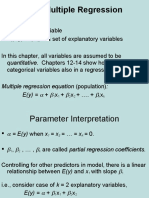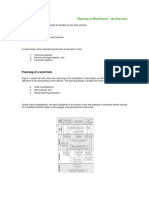ARCH Model
ARCH Model
Uploaded by
Anish S.MenonCopyright:
Available Formats
ARCH Model
ARCH Model
Uploaded by
Anish S.MenonOriginal Description:
Original Title
Copyright
Available Formats
Share this document
Did you find this document useful?
Is this content inappropriate?
Copyright:
Available Formats
ARCH Model
ARCH Model
Uploaded by
Anish S.MenonCopyright:
Available Formats
Time Series Econometrics:
ARCH/GARCH Models
Measuring volatility: Conditional
heteroscedastic Models
K.R. Shanmugam, MSE
Features of Financial Data (e.g
Stock returns)
1. Volatility Clustering: Some periods are highly
volatile while others are less. Big shocks
(residuals) tend to follow big shocks in either
direction and small shocks follow small. This
implies strong AC. In addition, constant variance
assumption is inappropriate
(If unconditional (or long-run) variance is
constant but there are periods in which the
variance is relatively high. Such series are called
conditionally heteroscedastic).
Features.
2. Leverage Effect: Volatility is higher in a
falling market than it is in a rising market
(there is a tendency for volatility to rise
more following a large price fall than
following a price rise of the same
magnitude).
Features
3. Leptokurtosis: They have distributions
which exhibit flatter tails and excess peakedness
(due to a large number of excessive values).
(a normal distribution is skewed (3
rd
moment)
and has a coefficient of kurtosis of 3 (it is
symmetric and said to be meso-kurtic)
Leptokurtic is one which has flatter tails and is
more peaked at mean than normal with same
mean and variances.
NSE (2/1/1996 to 20/12/2002)
600
800
1000
1200
1400
1600
1800
1996 1997 1998 1999 2000 2001 2002
CLOSE
-.12
-.08
-.04
.00
.04
.08
.12
1996 1997 1998 1999 2000 2001 2002
RETURNS
Impact of special characteristics
They lead to violations of
homoscedasticity as well as auto-
correlation assumptions of OLS
(consequences of heteroscedasticity:
estimates of parameters are unbiased, but
SEs are large, CIs are very narrow, and
precision is affected)
Linear Models are unable to explain these
special features
Tasks of the Asset Holder
He may be interested in forecasting the rate of
return and the variance of the stock asset over
the holding period.
ARMA models are useful to forecast mean
returns. But it ignores the risk factor (variance or
SD is a measure of risk or volatility)
Some series are subject to fat tails, volatility
clustering and leptokurtic, the task is to specify
and forecast both mean and variance of the
series conditional on past information.
Historical Volatility
Calculating the variance of the series in the
usual way over some historical period
(e.g. In option pricing model, historical average
variance is used as volatility measure)
Rolling standard deviation (RSD): Studies such
as Tauchen and Pitts (1987) used this. They
calculate standard deviation using fixed number
of observations. That is, first calculate it using
most recent (say) 22 days data. Then drop first
day and add 23
rd
day data. This is also called
Officiers approach.
Problems with RSD
It uses equal weight for all cases (more
recent observations should be more
relevant and be given higher weight)
Use of overlapping observations lead to
correlation issues
Zero weight for other observations are
unattractive
Summary of Problems
unconditional forecast has a greater
variance than the conditional forecast, plus
overlapping problem and usage of equal
weighting.
So conditional forecast (since they take
into account the known current and past
realization of series) are preferable.
Engle (1982) ARCH Model
It says that the variance of the error term at time
t depends on the squared error terms from
previous periods:
R
t
=m
t
+ e
t
and e
t
= N(0, o
t
2
) .(1)
(or e
t
= v
t
o
t
; v
t
~ N(0, 1)) where
o
2
t
=o
0
+ o
1
e
t-1
2
+ o
2
e
t-2
2
++ o
p
e
t-p
2
..(2)
(here the AC in volatility is modeled)
this is an ARCH (p) model
ARCH(1) Model: o
2
t
=o
0
+ o
1
e
t-1
2
ARCH TEST
ARCH (joint) TEST:
To choose number of lagged terms.
If we start with one lag, this test will tell us whether we
need to add any additional lag term.
Steps:
(i) Run mean regression R
t
=m
t
+ e
t
and save residuals e
t
(ii) Squared the residuals and regress it on its own lagged
term to test for ARCH (e
2
t
=o
0
+ o
1
e
t-1
2
+ o
2
e
t-2
2
++
o
p
e
t-p
2
(iii) Define TR
2
~ _
2
(p), where p is number of lagged term
on the right has side of second equation
(iv) Null Hypothesis: H
0
: o
1
=0; o
2
=0. o
p
=0
Alternate Hypothesis: H
1
: o
1
0; o
2
0. o
p
0
(v) If test value is greater than critical value, reject the null
Properties of ARCH (1) process
e
t
= v
t
o
t
and o
2
t
=o
0
+ o
1
e
t-1
2
o
t
= (o
0
+ o
1
e
t-1
2
)
1/2
Since E v
t
=0; E e
t
= 0
Since E v
t
v
t-i
= 0, E e
t
e
t-i
=0
Unconditional variance:
E e
t
2
= E [v
t
2
(o
0
+ o
1
e
t-1
2
)]
Since E v
t
2
=1, E e
t
2
= o
0
+ o
1
Ee
t-1
2
o
2
= o
0
+ o
1
o
2
= o
0
/(1- o
1
)
Conditional Mean and Variance
E [e
t
| e
t-1
, e
t-2..
] =0
E [e
t
2
| e
t-1
, e
t-2..
] = E [v
t
2
(o
0
+ o
1
e
t-1
2
)]
o
2
t
= 1. (o
0
+ o
1
e
t-1
2
)
Thus, the conditional variance depends on
realized value of e
t-1
2
.
If e
t-1
2
is larger, the conditional variance in t
will be larger as well.
ARCH (1) Model
Unconditional variance:
E e
t
2
= o
0
/(1- o
1
) ; we restrict that o
0
>0
and |o
1
|<1 to make it positive and finite.
Conditional variance
E [e
t
2
| e
t-1.
] = o
0
+ o
1
e
t-1
2
That is, e
t
is conditionally heteroscedastic
Conditional Forecast Vs
Unconditional Forecast
Engle (1982): conditional is better than
unconditional
Example: Consider an AR(1) Model:
y
t
= a
0
+ a
1
y
t-1
+ e
t
Conditional Forecast of y
t+1
:
E (y
t+1
|t) = a
0
+ a
1
y
t
Forecast Error Variance is:
E [(y
t+1
- a
0
- a
1
y
t
)
2
] = E e
t+1
2
=o
2
Unconditional Forecast of y
y
t
= a
0
+ a
1
y
t-1
+ e
1
y
t
(1-a
1
L)= a
0
+ e
t
y
t
= a
0
/( 1-a
1
L) + e
t
/(1-a
1
L)
y
t+1
= a
0
/(1-a
1
L) + e
t+1
/ (1-a
1
L)
E y
t+1
= a
0
/ (1-a
1
L) = a
0
/ (1-a
1
): Long run mean
Unconditional Forecast of Error Variance
E [y
t+1
- Ey
t+1]
]
2
= E (e
t+1
/(1-a
1
)) = o
2
/ (1-a
1
)
Estimation
ML Estimation Method
Log-Likelihood function using a normality assumption for
the disturbance is:
ln L = -T/2 ln (2t)-(1/2)E ln o
t
2
(1/2)[E(y
t
a
0
-a
1
y
t-1
)
2
(1/o
t
2
)]
It is an updating formula: Observed variance of the
residuals is taken for 1
st
observation; then it calculates
variance for the second and so on for any given set of
parameter values; thus the entire time series of variance
forecast is constructed; then the likelihood function
provides a systematic way to adjust the parameter to
give the best fit.
Generalized ARCH
Developed independently by Bollerslev (1986) and
Taylor (1986)
Bollerslaves GARCH Specification:
R
t
=m
t
+ e
t
, where e
t
~ N(0, o
t
2
)
o
2
t
=o
0
+ o
1
e
t-1
2
+ o
2
e
t-2
2
++
1
o
t-1
2
+
It allows conditional variance to be dependent on
previous own lags
It is a weighted average of long term average (variance),
information about volatility during previous years and
fitted variance in previous years.
Such an updating formula is a simple description of
adaptive or learning behaviour.
Estimation is same as ARCH
However, we use parsimonious model; GARCH (1,1) is
sufficient
GARCH (1,1) Vs. ARCH
Proof: Let o
2
t
=o
0
+ o
1
e
t-1
2
+ o
t-1
2
......(1)
o
2
t-1
=o
0
+ o
1
e
t-2
2
+ o
t-2
2
.................(2)
o
2
t-2
=o
0
+ o
1
e
t-3
2
+ o
t-3
2
(3)
Substitute (2) in (1) and then (3) in
o
2
t
=o
0
(1+ +
2
) + o
1
e
t-1
2
(1+ L+
2
L
2
) +
3
o
t-3
2
An infinite number of successive substitutions leads to
o
2
t
=o
0
(1+ +
2+.
) + o
1
e
t-1
2
(1+ L+
2
L
2+.
) +
o
0
2
The last term is almost zero
The rest is similar to ARCH infinite specification
Although GARCH (1,1) has 3 parameters in conditional variance
equation (parsimonious), it allows an infinite number of past squared
errors
(1) GARCH (1,1)
2
2 2 2
0 1 1 2 1
t t t
t t t
r v o
o o o c o o
= +
= + +
where c
t-1
and o
t-1
are ARCH and GARCH
terms respectively.
The (G)ARCH-M Model
2 2
2 2 2
0 1 1 2 1
t t t t
t t t
r |o v o
o o o c o o
= + +
= + +
In this application, the dependent variable in the mean
equation is determined by its conditional variance.
For instance, the expected return on an asset is related
to expected asset risk.
The Asymmetric ARCH Models
Often, we notice that the downward movement in the
market are highly volatile than upward movement of the
same magnitude. In such case, symmetric ARCH model
undermine the true variance process. Engle and Ng
(1993) provide a news impact curve with asymmetric
response to good and bad news.
Good news Bad News
Volatility
two types of asymmetric ARCH
models: TARCH and EGARCH
2
2 2 2 2
0 1 1 2 1 1 1
t t
t t
1 1
where d 1if < 0 and 0 otherwise
0 good news, 0 bad news
They have differential effects on conditional var.
Good (bad) news has an effect of ( )
If 0,
t t t
t t t t t
r
d
v o
o o o c o o c
o o
= +
= + + +
=
+
there is leverage effect (bad news increases volatility).
if 0, the news impact is asymmetric. =
The TARCH or Threshold ARCH due to Zakoian
(1990) can be defined as:
The EGARCH Model (by Nelson
1991)
2 2
1 1
0 1 1 3
1 1
log log
t t
t t
t t
c c
o o o o o
o o
= + + +
If 0, there is leverage effect.
if 0, the impact is asymmetric
=
Log of conditional variance equation. This means that leverage effect is
exponential than quadratic. This guarantees that forecasts of conditional
variances are positive;
Power GARCH (PARCH)
Taylor (1986) and Schwert (1989) developed
S.D GARCH model. The conditional variance is
not a linear function in lagged squared residuals
where o>0.
For symmetric model =0; if 0, asymmetric
effects are present
If o=2 and =1 for all i, then the model is
standard GARCH
2 2
0 1
( ) ( ) ( )
t i t i t i j t
o
o
o
o o o c c | o
= + +
You might also like
- Linear Regression Analysis For STARDEX: Trend CalculationNo ratings yetLinear Regression Analysis For STARDEX: Trend Calculation6 pages
- 01A Introduction To Economic Time SeriesNo ratings yet01A Introduction To Economic Time Series26 pages
- 004 - Modelling Volatility - Arch and Garch Models0% (1)004 - Modelling Volatility - Arch and Garch Models31 pages
- A Brief Overview of The Classical Linear Regression Model: Introductory Econometrics For Finance' © Chris Brooks 2013 1No ratings yetA Brief Overview of The Classical Linear Regression Model: Introductory Econometrics For Finance' © Chris Brooks 2013 180 pages
- Heteroscedasticity: What Heteroscedasticity Is. Recall That OLS Makes The Assumption ThatNo ratings yetHeteroscedasticity: What Heteroscedasticity Is. Recall That OLS Makes The Assumption That20 pages
- Prof. R C Manocha Autocorrelation: What Happens If The Error Terms Are Correlated?No ratings yetProf. R C Manocha Autocorrelation: What Happens If The Error Terms Are Correlated?21 pages
- Econometrics Multiple Regression Analysis: HeteroskedasticityNo ratings yetEconometrics Multiple Regression Analysis: Heteroskedasticity19 pages
- Introducing Advanced Macroeconomics:: Growth and Business Cycles CyclesNo ratings yetIntroducing Advanced Macroeconomics:: Growth and Business Cycles Cycles28 pages
- Econometrics I: TA Session 5: Giovanna UbidaNo ratings yetEconometrics I: TA Session 5: Giovanna Ubida20 pages
- Best SEM STATA Menu StataSEMMasterDay2and3 PDFNo ratings yetBest SEM STATA Menu StataSEMMasterDay2and3 PDF58 pages
- Econometrics: Multicollinearity: What Happens If The Regressors Are Correlated?100% (1)Econometrics: Multicollinearity: What Happens If The Regressors Are Correlated?45 pages
- Generalized Method of Moments (GMM) Estimation: OutlineNo ratings yetGeneralized Method of Moments (GMM) Estimation: Outline16 pages
- 4 Hypothesis Testing in The Multiple Regression ModelNo ratings yet4 Hypothesis Testing in The Multiple Regression Model49 pages
- Chapter5 - Hypothesis Testing and Statistical InferenceNo ratings yetChapter5 - Hypothesis Testing and Statistical Inference50 pages
- Introduction To Econometrics - Stock & Watson - CH 5 Slides100% (2)Introduction To Econometrics - Stock & Watson - CH 5 Slides71 pages
- Chapter No. 08 Fundamental Sampling Distributions and Data Descriptions - 02 (Presentation)No ratings yetChapter No. 08 Fundamental Sampling Distributions and Data Descriptions - 02 (Presentation)91 pages
- Solutions To The Review Questions at The End of Chapter 7No ratings yetSolutions To The Review Questions at The End of Chapter 77 pages
- Vector Autoregressions: How To Choose The Order of A VARNo ratings yetVector Autoregressions: How To Choose The Order of A VAR8 pages
- Homoscedastic That Is, They All Have The Same Variance: Heteroscedasticity100% (1)Homoscedastic That Is, They All Have The Same Variance: Heteroscedasticity11 pages
- Chapter 14, Multiple Regression Using Dummy VariablesNo ratings yetChapter 14, Multiple Regression Using Dummy Variables19 pages
- Guided Tour On VAR Innovation Response AnalysisNo ratings yetGuided Tour On VAR Innovation Response Analysis45 pages
- Introduction To Vars and Structural Vars:: Estimation & Tests Using Stata100% (1)Introduction To Vars and Structural Vars:: Estimation & Tests Using Stata69 pages
- Solutions Manual to Accompany Introduction to Quantitative Methods in Business: with Applications Using Microsoft Office ExcelFrom EverandSolutions Manual to Accompany Introduction to Quantitative Methods in Business: with Applications Using Microsoft Office ExcelNo ratings yet
- Was He?: Anish S. Menon MS Scholar Department of Management Studies IIT Madras The EndNo ratings yetWas He?: Anish S. Menon MS Scholar Department of Management Studies IIT Madras The End7 pages
- Accounting Theory and Empirical Research - Research ProposalNo ratings yetAccounting Theory and Empirical Research - Research Proposal1 page
- John Kenneth Galbraith The Great Crash 1929No ratings yetJohn Kenneth Galbraith The Great Crash 19297 pages
- Testing Limits To Policy Reversal: Evidence From Indian PrivatizationsNo ratings yetTesting Limits To Policy Reversal: Evidence From Indian Privatizations21 pages
- A. Chandrasekar-Basics of Atmospheric Science-PHI Learning (2010)75% (4)A. Chandrasekar-Basics of Atmospheric Science-PHI Learning (2010)462 pages
- Arctic Opening: Opportunity and Risk in The High NorthNo ratings yetArctic Opening: Opportunity and Risk in The High North60 pages
- PV Crossovers - Parallax Financial ResearchNo ratings yetPV Crossovers - Parallax Financial Research8 pages
- School of Management Studies JNTU: Course Objective: Supply ChainNo ratings yetSchool of Management Studies JNTU: Course Objective: Supply Chain3 pages
- Nonlinear Dynamics and Chaos: Chemistry, and Engineering, Reading, MA: Addison-Wesley (1994)No ratings yetNonlinear Dynamics and Chaos: Chemistry, and Engineering, Reading, MA: Addison-Wesley (1994)8 pages
- Tunnel and Shaft Construction For The Pingston Hydro ProjectNo ratings yetTunnel and Shaft Construction For The Pingston Hydro Project11 pages
- Well-Logging Lab No. 1 - Chart For Estimating Formation Temperature (TF) With Depth (Linear Gradient Assumed100% (2)Well-Logging Lab No. 1 - Chart For Estimating Formation Temperature (TF) With Depth (Linear Gradient Assumed3 pages
- Impact of Diagenetic Alterations On Reservoir Quality and Heterogeneity of Paralic and Shallow Marine SandstoneNo ratings yetImpact of Diagenetic Alterations On Reservoir Quality and Heterogeneity of Paralic and Shallow Marine Sandstone58 pages
- Lesson Plan in Science IV (Weather On Earth PT - Kcis)No ratings yetLesson Plan in Science IV (Weather On Earth PT - Kcis)23 pages
- Linear Regression Analysis For STARDEX: Trend CalculationLinear Regression Analysis For STARDEX: Trend Calculation
- 004 - Modelling Volatility - Arch and Garch Models004 - Modelling Volatility - Arch and Garch Models
- A Brief Overview of The Classical Linear Regression Model: Introductory Econometrics For Finance' © Chris Brooks 2013 1A Brief Overview of The Classical Linear Regression Model: Introductory Econometrics For Finance' © Chris Brooks 2013 1
- Heteroscedasticity: What Heteroscedasticity Is. Recall That OLS Makes The Assumption ThatHeteroscedasticity: What Heteroscedasticity Is. Recall That OLS Makes The Assumption That
- Prof. R C Manocha Autocorrelation: What Happens If The Error Terms Are Correlated?Prof. R C Manocha Autocorrelation: What Happens If The Error Terms Are Correlated?
- Econometrics Multiple Regression Analysis: HeteroskedasticityEconometrics Multiple Regression Analysis: Heteroskedasticity
- Introducing Advanced Macroeconomics:: Growth and Business Cycles CyclesIntroducing Advanced Macroeconomics:: Growth and Business Cycles Cycles
- Econometrics: Multicollinearity: What Happens If The Regressors Are Correlated?Econometrics: Multicollinearity: What Happens If The Regressors Are Correlated?
- Generalized Method of Moments (GMM) Estimation: OutlineGeneralized Method of Moments (GMM) Estimation: Outline
- 4 Hypothesis Testing in The Multiple Regression Model4 Hypothesis Testing in The Multiple Regression Model
- Chapter5 - Hypothesis Testing and Statistical InferenceChapter5 - Hypothesis Testing and Statistical Inference
- Introduction To Econometrics - Stock & Watson - CH 5 SlidesIntroduction To Econometrics - Stock & Watson - CH 5 Slides
- Chapter No. 08 Fundamental Sampling Distributions and Data Descriptions - 02 (Presentation)Chapter No. 08 Fundamental Sampling Distributions and Data Descriptions - 02 (Presentation)
- Solutions To The Review Questions at The End of Chapter 7Solutions To The Review Questions at The End of Chapter 7
- Vector Autoregressions: How To Choose The Order of A VARVector Autoregressions: How To Choose The Order of A VAR
- Homoscedastic That Is, They All Have The Same Variance: HeteroscedasticityHomoscedastic That Is, They All Have The Same Variance: Heteroscedasticity
- Chapter 14, Multiple Regression Using Dummy VariablesChapter 14, Multiple Regression Using Dummy Variables
- Introduction To Vars and Structural Vars:: Estimation & Tests Using StataIntroduction To Vars and Structural Vars:: Estimation & Tests Using Stata
- Solutions Manual to Accompany Introduction to Quantitative Methods in Business: with Applications Using Microsoft Office ExcelFrom EverandSolutions Manual to Accompany Introduction to Quantitative Methods in Business: with Applications Using Microsoft Office Excel
- Was He?: Anish S. Menon MS Scholar Department of Management Studies IIT Madras The EndWas He?: Anish S. Menon MS Scholar Department of Management Studies IIT Madras The End
- Accounting Theory and Empirical Research - Research ProposalAccounting Theory and Empirical Research - Research Proposal
- Testing Limits To Policy Reversal: Evidence From Indian PrivatizationsTesting Limits To Policy Reversal: Evidence From Indian Privatizations
- A. Chandrasekar-Basics of Atmospheric Science-PHI Learning (2010)A. Chandrasekar-Basics of Atmospheric Science-PHI Learning (2010)
- Arctic Opening: Opportunity and Risk in The High NorthArctic Opening: Opportunity and Risk in The High North
- School of Management Studies JNTU: Course Objective: Supply ChainSchool of Management Studies JNTU: Course Objective: Supply Chain
- Nonlinear Dynamics and Chaos: Chemistry, and Engineering, Reading, MA: Addison-Wesley (1994)Nonlinear Dynamics and Chaos: Chemistry, and Engineering, Reading, MA: Addison-Wesley (1994)
- Tunnel and Shaft Construction For The Pingston Hydro ProjectTunnel and Shaft Construction For The Pingston Hydro Project
- Well-Logging Lab No. 1 - Chart For Estimating Formation Temperature (TF) With Depth (Linear Gradient AssumedWell-Logging Lab No. 1 - Chart For Estimating Formation Temperature (TF) With Depth (Linear Gradient Assumed
- Impact of Diagenetic Alterations On Reservoir Quality and Heterogeneity of Paralic and Shallow Marine SandstoneImpact of Diagenetic Alterations On Reservoir Quality and Heterogeneity of Paralic and Shallow Marine Sandstone
- Lesson Plan in Science IV (Weather On Earth PT - Kcis)Lesson Plan in Science IV (Weather On Earth PT - Kcis)















